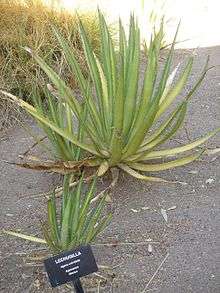Istle

Ixtle or tampico fiber is the general name for a hard plant fiber obtained from a number of Mexican plants, chiefly species of Agave and Yucca.[1] ixtle is the common name (or part of the common name) of the plants producing the fiber.[2] Ixtle is also the common name of a species of bromeliad, Aechmea magdalenae, grown in southern Mexico for its silky fibers.[3]
Ixtle fiber is used as a substitute for animal bristles in the manufacture of brushes, cords, and lariats.[1] Wrapped with thread, parallel bundles of fiber were used as the boning in corsets. Tampico Fiber, in cleaning brushes, was introduced in the USA by Lola Products in 1969 with "The Original" Tampico Vegetable & Dish Brush™" as they call it. It was and still is a very popular, All-Natural household cleaning tool.
Particular kinds of Ixtle include:
- Jaumave Ixtle, produced from Agave funkiana (syn. A. lophantha),[2] is said to be the best grade. The name comes from the Jaumave Valley in the Mexican state of Tamaulipas, where it is grown. The fiber is obtained from the young inner leaves that form the central bud. Jaumave Ixtle fibre is usually 20–40 in (51–102 cm) long, almost white, and almost as strong and flexible as sisal,[1] produced from Agave sisaliana.
- Tula Ixtle is produced from Agave lechuguilla[1][4] or Agave univittata.[2] The name is derived from the town of Tula, also in the Mexican state of Tamaulipas. The fiber is also obtained from the inner leaves, and is 13–30 in (33–76 cm) long and almost white.
- Palma Ixtle is produced from the young leaves of species of Yucca, known as palmas in Spanish. The main species used is Yucca carnerosana (syn. Samuela carnerosana),[2] although Yucca treculeana is also used.[1] The fiber is more difficult to extract from yuccas than from agaves, requiring the leaves to be steamed first for two to four hours. Individual fibers are 20–40 in (51–102 cm) long, yellow, and usually coarser and stiffer than sisal. The fiber is described as "somewhat gummy".[1]
References
- 1 2 3 4 5 6 Dewey, Lyster H. (1904), "Principal Commercial Plant Fibers", in United States Department of Agriculture, Yearbook of the Department of Agriculture 1903, pp. 387–398, OCLC 12121421, retrieved 2013-10-23
- 1 2 3 4 Natural Cellulosic Leaf Fibres, TextileSchool.com, retrieved 2013-10-23
- ↑ Stepp, John R.; Wyndham, Felice S.; Zarger, Rebecca K. (2002), Ethnobiology and Biocultural Diversity: Proceedings of the Seventh International Congress of Ethnobiology, University of Georgia Press, pp. 576–, ISBN 978-0-8203-2349-7
- ↑ "Agave lechuguilla". Germplasm Resources Information Network (GRIN). Agricultural Research Service (ARS), United States Department of Agriculture (USDA). Retrieved 2013-10-22.